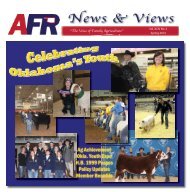Oklahoma Farmers Union - American Farmers & Ranchers
Oklahoma Farmers Union - American Farmers & Ranchers
Oklahoma Farmers Union - American Farmers & Ranchers
Create successful ePaper yourself
Turn your PDF publications into a flip-book with our unique Google optimized e-Paper software.
the State of Sequoyah. While the proposed constitution was ratified by voters of Indian<br />
Territory, Congress refused to grant the area statehood.<br />
This convention would later impact the writing of <strong>Oklahoma</strong>’s constitution in that<br />
it reflected the Progressive Era. It featured strict corporate regulation, humanitarian<br />
measures allowing the government to assist the underprivileged and almost every demand<br />
of the growing progressive cause. <strong>Farmers</strong> <strong>Union</strong> member William H. Murray was at the<br />
table serving as a vice president of the Sequoyah Convention.<br />
Congress settled the issue by combining both territories into a single state. On<br />
June 16, 1906, President Theodore Roosevelt signed into law the <strong>Oklahoma</strong> Enabling<br />
Act. The Act stipulated the Twin Territories were to begin preparation for admittance<br />
into the <strong>Union</strong> as a single state.<br />
Following the direction of statehood, in 1907, the two unions became one and<br />
were re-chartered as the <strong>Oklahoma</strong> State <strong>Union</strong>, allaying the bitterness and strife that had<br />
existed between members during the state debate. A compromise was forged when<br />
officers from both unions formed the new union board at the Aug. 20, 1907, state meeting<br />
in Shawnee. Membership totaled 50,000.<br />
State Constitution Influence<br />
<strong>Farmers</strong> <strong>Union</strong> was at the table during a meeting in Shawnee when the “Shawnee<br />
Demands” were drafted, reflecting membership goals to be included in a state<br />
constitution.<br />
Shawnee Demand provisions included: (1) initiative and referendum; (2) recall;<br />
(3) vast authorization for the government to involve itself in industry; (4) limited workday<br />
(eight hours) for certain professions; (5) government regulation of railroads; (6)<br />
elected officials to regulate labor and agriculture; (7) election of all state officials; (8)<br />
government ownership of utilities; (9) antimonopoly statutes; and (10) a ban on child<br />
labor.<br />
Many of the demands were the basis of the <strong>Farmers</strong> <strong>Union</strong>s beginnings in fighting<br />
corporations.<br />
Most successfully elected delegates adopted the Shawnee Demands.<br />
The delegates assembled in Guthrie on November 20, 1906. Demographically, of<br />
the 55 <strong>Oklahoma</strong> Territory seats, 30 were <strong>Farmers</strong> <strong>Union</strong> members. Thirty-four of Indian<br />
Territory’s 55 were supporters of the Sequoyah Convention. These numbers combined<br />
with the fact that 98 were staunch Democrats, producing a vote which Murray had<br />
figured to the man well in advance of the convention.<br />
Murray also served as draftsman and leader in the writing of the by-laws of the<br />
<strong>Oklahoma</strong> <strong>Farmers</strong> <strong>Union</strong> and went on to become the first Speaker of the <strong>Oklahoma</strong><br />
House of Representatives and the state’s ninth governor.



